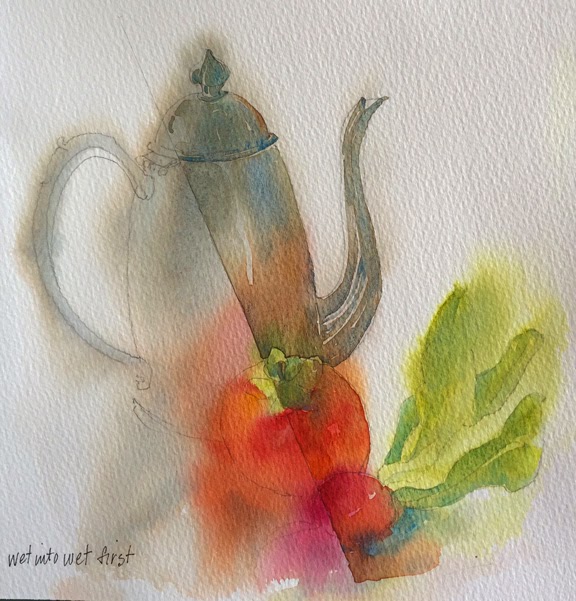Loosening up is a common topic of conversation amongst my students – as in “I want to loosen up!” When I ask them why, they have a hard time articulating an answer but it has something to do with what they think watercolor painting should be. I suspect it has more to do with the ease of brushwork in experienced painters rather than a method of applying paint. So I try to gently talk to them about the goal of painting – we each have to find our own language as a painter and to find that takes LOTS of painting. As in everything in our fast-paced world, beginners want to “get there” asap. Too bad it doesn’t work that way. Or rather, isn’t it lovely that it works that way. Painting isn’t a new craft that you learn and do for a week or two and then move on to the next new fad. It’s such a demanding, fulfilling, fascinating journey that it can last an entire lifetime.
There is an exercise that I recommend if new painters are wanting to find a way to work that feels more unstructured. You really can’t get too tight when you use the wet-into-wet application of paint.
After drawing the subject on watercolor paper, either immerse the sheet in a tub of water or sponge water on both the front and the back of the paper. With the former, wait several minutes so the paper is thoroughly soaked. Grab the sheet by 2 corners and let the water sluice off the page. Then turn it diagonally so more can drip off. Then “walk” the paper down the board – a board that is non-absorbent. By walking I mean laying the paper down from the bottom to the top making sure that each area is right next to the board. If there is a soft wrinkle, lift the nearest corner and walk it down again Watch for areas where the paper seems to have a bubble beneath the paper and if you see any, lift from the corner and lay it flat again. Any air beneath the watercolor paper will make it more difficult when you begin to paint. If you have used a sponge to wet the paper, do the same method of adhering the paper to the board.
You’ll need to wait for the glisten to leave the surface before you begin to paint. Sometimes I’ve been successful at hurrying up the drying time by blotting the paper surface with a towel but there is a danger of taking too much water off. You have to experiment with this part…what is too dry and what is too wet. Experience will tell you what the surface should look like for the optimum time to add paint.
 |
| Pewter Teapot & Radish |


2 Comments
thevaliantx
November 20, 2015Thank you, Judy!
thevaliantx
November 20, 2015Thank you, Judy!